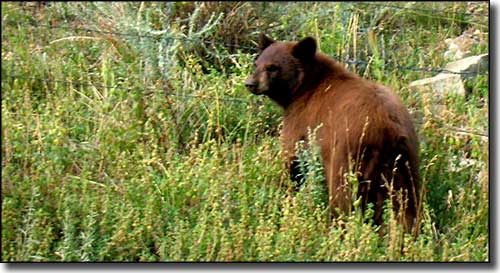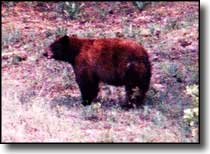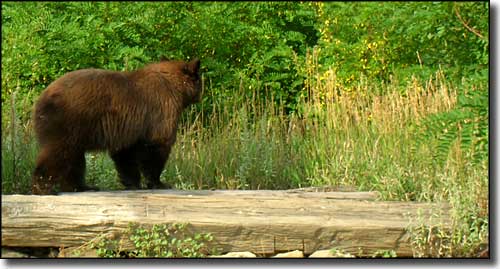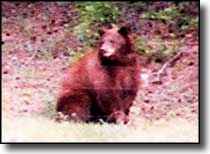 |
Living with Wildlife - Black Bear |
|
|
 |

Black bears are the most common and generally the smallest of North American bears. Population estimates of black bears in Colorado range from 8,000 to 12,000 bears. Some black bears live up to 20 years in the wild and up to 30 years in captivity. They are strong swimmers, good climbers, very agile, can run in bursts up to 35 miles per hour, and can run up and down hill like nothing. If you have an encounter, don't plan on outrunning the bear. Threats to black bears include disease, accident, starvation and motor vehicles. While their natural enemies include mountain lions and other bears, their biggest problems come from humans through loss of habitat, illegal killing, feeding, and destruction of bears that pose a threat to people, livestock and property. Before 1935, black bears were subject to unlimited hunting. In 1935 they were designated as game animals, which provided for their management and protection. Current hunting regulations prohibit the use of dogs and bait, and protect cubs and females with cubs. Black bears aren't always black, they may be blond, brown, honey-colored, black or mixed. They may have a white spot on their chest or a tan muzzle. Supported by short, powerful legs, the high point on a black bear is the lower middle of its back. Unlike grizzly bears, they have no prominent shoulder hump. Adult males average 275 pounds while adult females average 175 pounds. Depending on gender, season and food supply, they can weigh anywhere from 125 pounds to 450 pounds. They measure about 3 feet high when on all fours and up to 5 feet tall when standing on their hind legs. Their front foot tends to be short and 4-5 inches wide. Their hind feet are about 7 inches long and narrow and the hind track closely resembles a human footprint. Bears prefer trails, just like people do: it's easier than thrashing around in the underbrush. When you are in bear country, keep your eyes out for tracks, droppings and other bear signs: rotten logs ripped apart, hair on tree bark from rubbing and claw marks on trees. Their droppings are sizable and composed of partly digested berries, plant leaves, seeds, or animal hair. While bears may gather at a place where there's lots of food to eat, they are solitary creatures. Usually, the only time you'll come across more than one bear at a time is when they are breeding or you find a sow with cubs. While their vision is good (they can see colors, form and movement), they rely more on their acute senses of smell and hearing to locate food and warn them of danger. Adults make a variety of sounds but what's most commonly heard is woofing and jaw-popping. Cubs whimper and bawl. In Colorado, the largest black bear populations are found in areas full of Gambel's oak (scrub oak) and aspen near open areas of serviceberry and chokecherry bushes. Every bear determines and protects its home range. That home range may cover 10 to 250 square miles. Adult males occupy the largest home ranges while adult females will usually establish their home range close to their mothers. |
 |

Bears are most active during morning and evening twilight but they can be active any time of day or night. When not eating or shopping for food, they like to rest in a day bed: in dense brush, in a depression in the rock or dirt, or next to a windfallen log. About 90% of a bear's diet comes from nutritious plants and the remaining 10% comes from animals it came across. Bears will eat berries, nuts, insects, carrion, grasses, and broad-leafed flowering plants. In late summer, when they are fattening up for winter hibernation, they may eat 20,000 calories per day and feed up to 20 hours per day. In Colorado, come hibernation time, females enter their dens in late October and males in early November. Bears commonly den in excavated holes beneath shrubs or trees, in hollow logs, rotten trees, brush thickets, and rock caverns. Bears may leave the den when snow is still on the ground and many of them will move to lower elevations where the spring greenup has already begun. A few female bears may have cubs at 3 or 4 years of age but 5 years old is more common. Males are capable of breeding at 3 years of age. They mate in early summer but development of fertilized eggs is delayed until hibernation time. If a pregnant female goes into hibernation in poor condition, she will most likely reabsorb the egg rather than continue fetal development. She generally won't breed again while her cubs are with her. After a 2-3 month gestation period, 1 to 3 (usually 2) tiny cubs are born in midwinter. They are toothless, blind and covered with very fine hair. Their mother's rich milk grows them from less than 1 pound at birth to 10-15 pounds when the family emerges from the den in mid-May. Care of the cubs is completely on the mother. The cubs learn by watching and mimicking her. Most cubs stay with their mother for one year. Black bears will eat almost anything including human food, hummingbird food, pet food, livestock food, and garbage. If you leave any of these things easily accessible, you will have a bear problem. And the primary solution to a bear problem is to trap and move the bear, or kill it. To prevent this, keep your garbage out of reach and smell of bears. Use bear-proof trash containers and empty and clean them regularly. Don't store pet food or feed pets outside. Clean the grease off your BBQ and store it inside. Hang bird feed, suet and hummingbird feeders on a high wire between trees and not on a porch or deck. Bring all bird feeders in at night. Do not put melon rinds, fruit or other food in mulch or compost piles. Bears usually don't cause any problems unless they find lots of food. If they don't find food, they move on. Although bears are generally shy and avoid contact with humans, there are some precautions you can take to avoid encounters when you are hiking or camping in bear country:
In most cases, a bear will sense you first and move to avoid you. Bear attacks are rare compared to the number of close encounters. However, if you do happen to stumble upon a bear, here are some suggestions what to do:
If you somehow end up in a life-threatening situation with a black bear, or if you are injured by one, please contact the Division of Wildlife, the State Patrol or your local sheriff's department. |
|
|
 |
| Index - Arizona - Colorado - Idaho - Montana - Nevada - New Mexico - Utah - Wyoming National Forests - National Parks - Scenic Byways - Ski & Snowboard Areas - BLM Sites Wilderness Areas - National Wildlife Refuges - National Trails - Rural Life Advertise With Us - About This Site - Privacy Policy |
| Photos courtesy of Sangres.com, CCA ShareAlike 3.0 License. Text Copyright © by Sangres.com. All rights reserved. |